Definition, Indications, Objectives and Principles
Lipofilling, liposculpture or autografting of fatty tissue is a technique that involves taking small quantities of fat from the patient's body and reinjecting it to fill the hollows formed by dark circles, scars, depressions or reshape a face.
Lipofilling is a concept developed in the '85s by Dr Fournier, a precursor of liposuction.
In 1995, autologous fat reinjection, also known as Lipostructure, became a truly reliable method (S. Coleman).The principle is to perform a genuine autograft of fat cells by reinjecting fat taken from the patient himself.
Fat is removed from the body, mainly from the inner knees, thighs or abdomen, then injected in small quantities into the target area at two or three levels of depth (periosteum, muscles and hypodermis). The advantages of this practice are clear: no allergic reactions, correction of large volumes and improvement of the trophicity of the skin in the area concerned. However, superficial fine lines cannot be treated by this technique and must be dealt with by other injectables.
Lipostructure can be applied to a large number of natural or post-traumatic depressions (hollows), and the objectives and indications of this type of procedure can be summarized as follows:
AESTHETIC INDICATIONS
- Filling and softening certain wrinkles, particularly on the face;
- Restoration of facial volume and shape: this may involve restoring a face that has become emaciated as a result ofageing or significant weight loss;
- A complement to certain cervico-facial lifts to improve facial harmony, or rhinoplasty in the nasolabial folds;
- Secondarily, after a first facelift, to improve the shape of the middle third of the face without the need for a new facelift.
INDICATIONS FOR RECONSTRUCTIVE SURGERY
- Filling a tissue depression following trauma;
- Correction of fat melting after tritherapy in HIV+ patients.
Pre-operative consultations
The initial consultation enables the surgeon to assess the patient's expectations, as well as the aesthetic and psychological impact of the problem.
The consultation begins by examining the patient's motivations.
A thorough medical and surgical history is essential.
The surgeon then examines the patient to assess the patient's request, its feasibility and the quality of the skin.
It is essential to carry out a meticulous clinical and photographic study of the corrections to be made, particularly in the case of lipostructure for facial rejuvenation. The aging process must be studied on photographs taken when the patient was young, compared with the current state.
This in-depth examination enables the surgeon to propose a technique adapted to the patient's case, and to specify the procedure and type of anesthesia (local or assisted local).
Certain associated procedures such as cervical liposuction may be discussed.
A photographic assessment is then carried out.
The patient will be given a detailed description of the usual post-operative follow-up and any complications. The patient will then be given a detailed information sheet on the planned operation, to complete his or her information and enable him or her to make informed decisions.
The surgeon's and anaesthetist's fees will be specified, and the patient will be given an estimate of all costs to be considered.
The second consultation provides a personalized response to any questions the patient may have. A new clinical examination allows us to validate the treatment proposal initially envisaged and to project the patient's future based on the photographic assessment.
Foranaesthesia (local potentiated or local pure), it is often necessary to carry out certain biological preoperative tests and to have an anaesthesia consultation. No aspirin-containing medication should be taken in the 10 days preceding the operation.
The estimate will again be discussed and signed by the practitioner and the patient.
The intervention
TYPE OF ANESTHESIA
Lipostructure is usually performed under deep local anesthesia using intravenous tranquilizers ("vigile" anesthesia). Simple local anesthesia, or even general anesthesia, may also be used .
The choice between these different techniques will be the fruit of a discussion between you, the surgeon and the anaesthetist.
HOSPITALIZATION ARRANGEMENTS
This surgery is almost always performed on an outpatient basis, with admission and discharge on the same day.
You should enter the hospital at least one hour before the scheduled time of surgery, having fasted for at least six hours. The patient is generally discharged three to five hours after the end of the procedure.
You must be accompanied when you return home and not be alone the night after the procedure.
THE INTERVENTION ITSELF
The procedure begins with the precise identification of the fat harvesting areas and the reinjection sites.
The fatty tissue is removed atraumatically through a micro-incision hidden in the natural folds, using a very fine suction cannula, in an area where there is a reserve or excess of fatty tissue.
.jpg)
.jpg)
Centrifugation, Colemann method
This is followed by a few minutes' centrifugation to separate the intact fat cells, which will be grafted, from the non-graftable elements.
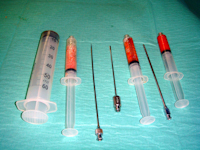
.jpg)
Sampling cannulas and syringes Appearance after centrifugation
Reinjection of fat tissue is performed through incisions of less than 1 mm using micro-cannulas.
The injection of mini fat lobules in different planes and in multiple, divergent directions will ensure the survival of the grafted fat cells.
The grafted cells will remain alive in the body, making lipostructure a permanent technique, since the fat cells will live as long as the tissue around them.
The injection points are closed with a dressing or absorbable stitch, and are located in a fold.
The duration of the procedure depends on the quantity of fat to be reinjected and the number of locations to be treated, averaging 30 minutes. Another procedure may be performed at the same time.
Post-operative care and follow-up
POST-OPERATIVE CARE
This is a painless procedure.
Tissue swelling (edema) occurs for 48 hours after the procedure, and usually takes 5 to 15 days to resolve completely.
Ecchymoses (bruises) may appear in the first few hours in the areas of fat reinjection or harvesting: these will disappear within 10 to 20 days after the procedure. It is these bruises that may pose a problem for the immediate resumption of social activities.
Operated areas should not be exposed to sunlight or UV light for at least 4 weeks, as this would entail the risk of permanent pigmentation.
THE RESULT OF LIPOFILLING
It is assessed three to six months after the operation.
However, the result may gradually deteriorate, due to the natural aging process of these same tissues.
Injecting fat cells not only fills a depression, but also improves the quality of the skin around the injection by adding tissue growth factors.
Post-operative concerns and complications of lipofilling
IMPERFECT RESULTS
In some cases, localized imperfections may be observed (without constituting real complications): insufficient localized correction, slight asymmetry, irregularities.
As a general rule, they can be treated with an additional lipostructure "touch-up" under local anaesthetic from the sixth postoperative month onwards to perfect the result.
POSSIBLE COMPLICATIONS
Lipoaspiration is a genuine surgical procedure, which implies the risks associated with any medical procedure, however minimal.
Complications of anesthesia are always possible, even if the anesthesia is light and brief.
Such a procedure must be carried out in a surgical operating theatre.
Infection is usually prevented by prescribing antibiotics intra- and post-operatively.
Hypercorrection: the most frequent complication following lipostructure, hypercorrection is linked to the reinjection of an excessive quantity of fat, resulting in overcorrection and excess volume that can be unsightly. In most cases, hypercorrection can only be corrected by a repeat operation involving surgical removal of the excess fat*.
It's important not to overestimate the risks, but simply to be aware that any surgical procedure, no matter how apparently simple, always involves a small degree of risk;
Genuine complications are exceptional, and a rigorous approach to the indication and surgical procedure should ensure effective, real-world prevention, especially when using foam cannulas that respect the skin, vessels and nerves.
Examples of results
Treatment of scars with skin atrophy
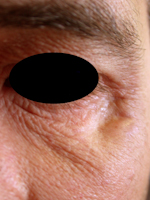
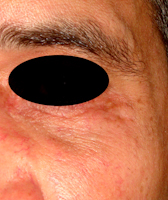
Scar with skin atrophy Appearance after injection, filling the depression and improving the quality of the surrounding skin
Treatmentof surgical and radiotherapeutic sequelae
Sequelae of extensive surgery with radiotherapy
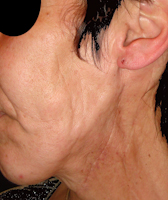
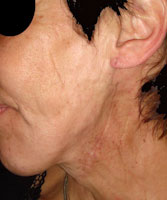 Aspect 6 months after a lipofilling session, additional injections can be scheduled.
Aspect 6 months after a lipofilling session, additional injections can be scheduled.
.jpg) |
.jpg) |
| Pre-operative appearance | Pre-operative appearance |
.jpg) |
.jpg) |
| Post-operative appearance | Post-operative appearance |
Treatment of localized lipoatrophy
.jpg)
.jpg)
.jpg)
Preoperative appearance of premalar lipoatrophy
.jpg)
.jpg)
.jpg)
Appearance 6 months post-op
Global facial treatment
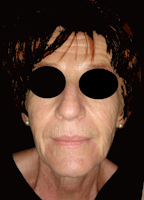
.jpg)
.jpg)
.jpg)
Pre-operative appearance
.jpg)
.jpg)
.jpg)
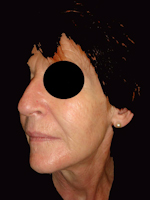
Post-operative appearance

